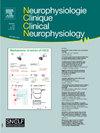Short-interval intracortical inhibition (SICI): effect of target tracking on variability of responses for 1 mV and 200µV test-alone targets
IF 2.4
4区 医学
Q2 CLINICAL NEUROLOGY
Neurophysiologie Clinique/Clinical Neurophysiology
Pub Date : 2025-07-09
DOI:10.1016/j.neucli.2025.103091
引用次数: 0
Abstract
Objective
To evaluate whether continuously tracking unconditioned thresholds for maintaining constant motor-evoked potential (MEP) amplitudes improves the variability of amplitude-based short-interval intracortical inhibition (SICI) measurements.
Methods
Fifty-five healthy subjects were tested twice on two days with six SICI protocols. Conditioning stimulus (CS) intensity was set to 70 % of the resting motor threshold for a 200µV target (RMT200), while test stimulus (TS) intensity targeted MEP of either 1 mV or 200µV. Protocols included conventional A-SICI (fixed CS and TS), hybrid A-SICI (fixed CS and updated TS by threshold tracking); tracked A-SICI (both CS and TS updated by threshold tracking). Variability in unconditioned and conditioned responses was analyzed across interstimulus intervals (ISIs) of 1, 2.5, and 3 ms.
Results
Threshold-tracking reduced variability of the unconditioned responses measured by geometric standard deviation (expressed as a factor) for 1 mV (×/÷1.61 to 1.39; p<0.0001) and 200µV targets (×/÷2.21 to 1.30; p<0.0001). However, variability of inhibition measures did not differ significantly across protocols. Inhibition with the 200µV MEP target was significantly less than with 1 mV across all ISIs (p<0.001). The A-SICI 200µV tracked protocol showed reliability comparable to A-SICI fixed 1 mV, suggesting it may be a practical alternative in clinical populations where achieving a 1 mV MEP is challenging, such as in patients with severe muscle denervation.
Conclusions
While threshold-tracking enhances unconditioned MEP reproducibility, it does not reduce the variability of SICI, which is highly dependent on target MEP size. These findings point towards two distinct mechanisms underlying conditioned and unconditioned responses and refine understanding of SICI variability.
短间隔皮质内抑制(SICI):目标跟踪对1 mV和200µV单独测试目标反应变异性的影响
目的评价连续跟踪维持恒定运动诱发电位(MEP)振幅的非条件阈值是否能改善基于振幅的短间隔皮质内抑制(SICI)测量结果的可变性。方法55名健康受试者采用6种SICI方案,在2天内进行2次检测。条件刺激(CS)强度设定为200µV目标(RMT200)静息运动阈值的70%,而测试刺激(TS)强度设定为1 mV或200µV。协议包括传统的A-SICI(固定CS和TS),混合A-SICI(固定CS和更新阈值跟踪TS);跟踪A-SICI (CS和TS都通过阈值跟踪更新)。在刺激间隔(ISIs)为1、2.5和3 ms时,分析了非条件反应和条件反应的变异性。结果阈值跟踪将几何标准差(以因子表示)测量的非条件反应的变异性在1 mV (x /÷1.61)至1.39;p<0.0001)和200µV靶(×/÷2.21至1.30;术中,0.0001)。然而,抑制措施的可变性在不同的方案中没有显著差异。在所有ISIs中,200µV MEP靶的抑制作用明显小于1 mV (p<0.001)。a - sici 200µV跟踪方案显示出与a - sici固定1mv相当的可靠性,这表明它可能是临床人群中实现1mv MEP具有挑战性的实用替代方案,例如严重肌肉失神经患者。结论阈值跟踪虽然提高了无条件MEP的再现性,但并没有降低SICI的变异性,后者高度依赖于目标MEP的大小。这些发现指出了条件反应和非条件反应的两种不同机制,并完善了对SICI变异性的理解。
本文章由计算机程序翻译,如有差异,请以英文原文为准。
求助全文
约1分钟内获得全文
求助全文
来源期刊
CiteScore
5.20
自引率
3.30%
发文量
55
审稿时长
60 days
期刊介绍:
Neurophysiologie Clinique / Clinical Neurophysiology (NCCN) is the official organ of the French Society of Clinical Neurophysiology (SNCLF). This journal is published 6 times a year, and is aimed at an international readership, with articles written in English. These can take the form of original research papers, comprehensive review articles, viewpoints, short communications, technical notes, editorials or letters to the Editor. The theme is the neurophysiological investigation of central or peripheral nervous system or muscle in healthy humans or patients. The journal focuses on key areas of clinical neurophysiology: electro- or magneto-encephalography, evoked potentials of all modalities, electroneuromyography, sleep, pain, posture, balance, motor control, autonomic nervous system, cognition, invasive and non-invasive neuromodulation, signal processing, bio-engineering, functional imaging.

 求助内容:
求助内容: 应助结果提醒方式:
应助结果提醒方式:


